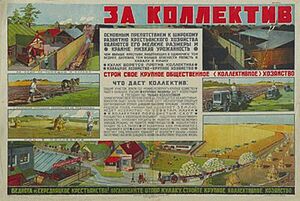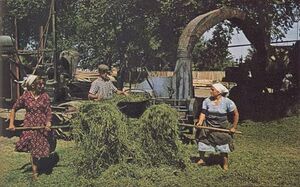Collectivization


Collectivization is a policy of uniting individual farmers into state-run collective farms. These collective-farms are the combination of industry and agriculture under Socialist communal ownership. It organizes agriculture to be under the state economic plan which allows for easier management and distribution of food and controlled production. [1][2]
Collectivization by country
Soviet Union
Collectivization was used in the Soviet Union to allow the state to control agriculture and put it under socialist ownership. It was instrumental in building the Soviet Economy and bringing the peasantry to the proletariat. The Soviet Union was originally a majority peasant state and collectivization was able to harness that. The Soviets unfortunately had fierce resistance to collectivization by the Kulaks. The Kulaks would destroy crops and livestock to avoid collectivization and this would amalgamate into one of the leading causes of the Soviet/Ukrainian Famine. [3][4]
Theory
An excerpt from the political economy textbook issued by the Economics Institute of the Academy of Sciences of the U.S.S.R.:
(1) Collectivisation of agriculture is an essential condition for building socialism. The essence of collectivisation is the gradual and voluntary union of the peasant farms in producer co-operatives. Collectivisation means the transition from small-scale, individual, backward private farming to large-scale socialist farming equipped with modern machine techniques. Collectivisation corresponds to the vital interests of the peasantry and all the working people.
(2) The most important prerequisites for all-round collectivisation are: the socialist industrialisation of the country, the development of agricultural cooperation, the experience of the first collective and State farms, which demonstrate to the peasantry the superiority of large-scale socialist farming, the creation of machine and tractor stations, and a decisive struggle against the kulaks.
(3) All-round collectivisation, and with it the elimination of the kulaks as a class, which was carried out under the leadership of the Communist Party and the Soviet State, was a most profound revolutionary transformation involving the transition from the bourgeois individual-peasant system to a new socialist collective farm system. This revolution eliminated the most numerous exploiting class--the kulaks--and turned the most numerous toiling class--the peasantry--from the capitalist to the socialist path of development. It created a firm socialist base for the Soviet State in agriculture.
(4) With the victory of the collective farm system, the Soviet Union was transformed from a country of small peasant farming to a country with the largest-scale agriculture in the world and a highly mechanised one. The productive forces of agriculture acquired scope for their development. The Soviet peasantry escaped for ever from exploitation, poverty and beggary were abolished in the countryside, and conditions for an uninterrupted improvement in the material and cultural life of the collective farm peasantry were created. The friendly alliance of the workers and peasants became strong.[5]
References
- ↑ https://www.marxists.org/history/ussr/government/1976/leninismagrarianpeasantquestionvol2.pdf
- ↑ https://www.marxists.org/subject/economy/authors/pe/index.htm
- ↑ https://www.marxists.org/history/ussr/government/economics/howcollectivefarmingwasestablishedussr.pdf
- ↑ https://www.marxists.org/reference/archive/stalin/works/1939/x01/ch11.htm
- ↑ https://www.marxists.org/subject/economy/authors/pe/pe-ch25.htm
